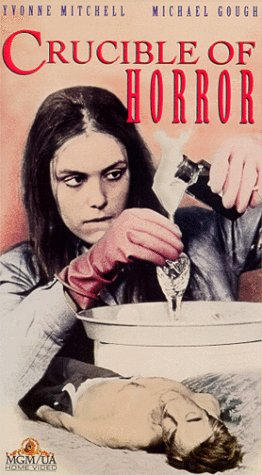|
Crucible of Horror Film review by Thomas M. Sipos |
|
MENU Books Horror Film Festivals and Awards
Pursuits
Blogs Horror Film Festivals and Awards
Other
|
Crucible of Horror (British 1969, dir: Viktors Ritelis; cast: Michael Gough, Yvonne Mitchell, Sharon Gurney, Simon Gough, aka The Corpse, The Velvet House)
I know this, because several film guides say so. I don't know how they all know this, as I was thoroughly confused, but it's as good an explanation as any. At least I am not alone in my confusion. To paraphrase Movie Macabre's Elvira at film's end: "Well, that's the end... I guess because the cameraman said, 'Hey, we shot enough film for a movie.' So the director said, 'Okay, let's stop shooting'." God help any movie when Elvira's putdowns actually prove cogent. Actually, Crucible of Horror is not so bad. It's tense and enjoyable. It just makes no sense. Michael Gough is the stern father, lording over his household. When his 16-year-old daughter (a lovely Sharon Gurney, looking older because, no doubt, she is) steals, Gough horsewhips her with a switch, leaving deep red scars. She's a bad girl, and as Gough is not one to spare the rod, this is a repeated ritual. During the beatings, Gough's wife (Yvonne Mitchell) cowers in another room. His son (Simon Gough) obliviously boogies to his music (using headsets to drown out sis's screams). When Gough leaves Sharon's room, Simon eagerly pops out to ask: "What's sis done now?" "Stealing," Gough bluntly replies. Simon enjoys sis's repeated comeupance. He also avoids the switch. He's a strapping young lad following Gough into the insurance business, the pride of his dad's loins. After one particularly nasty beating, mother and daughter resolve to kill Gough. And they do, apparently. Or maybe not. Gough's corpse keeps popping up in odd places. But not till late in the film, and even then we're not certain if it's under his own volition, or if it's being moved. And then things only get ever muddier... You'll have to watch and decide for yourself if any of this makes sense. Now that I've clued you in, maybe it'll make some sense as you watch.
Crucible of Horror is nicely atmospheric in portraying the English suburbs and countryside, although for most of the film one gets the impression that one is watching a suspense thriller rather than a horror film. Gough provides the standout performance as the father. Especially chilling (and funny, in an extremely dark sense) is his serenity before and after his savage beatings. Discussing mundane trivia as though nothing of any import has occurred. Calm demeanor, placid voice, unruffled manner. His daughter absent from breakfast, Gough nonchalantly asks, "Where's Jane?" An innocent question that carries dread for the mother and viewer, as we know what may follow. Or not. Gough is ever calm, and not every transgression is met with ferocity. No telling which innocent question precedes his fury.
Although confusing and slow-moving, Crucible of Horror has its defenders. In Fragments of Fear: An Illustrated History of British Horror Films, Andy Boot calls the film "interesting," adding: "While the script was nothing to write home about, the performances from Gough, Sharon Gurney, and Yvonne Mitchell are all strong, and the director shows some imagination in the handling of the subject, with good use of unusual angles."
One way to handle obscurity is to look for a theme. Themes elevate the obscure into the profound. The Overlook Encyclopedia says the film: "could be seen as an allegory indicating that killing a patriarch doesn't eliminate patriarchy." Okay. That'll work. Even so, I still think Elvira was nearest the truth. The poor vampress was befuddled throughout the film because it was a befuddling film. And to her credit, she had the courage of her convictions, looking beyond themes, and simply pronouncing that the emperor had no clothes. Crucible of Horror is not a bad film, but better if you read about it before seeing it. That way, you'll know what the film's about as you view it. Also, not to be confused with another British horror film, Crucible of Terror (1971). Review copyright by Thomas M. Sipos
|
"Communist Vampires" and "CommunistVampires.com" trademarks are currently unregistered, but pending registration upon need for protection against improper use. The idea of marketing these terms as a commodity is a protected idea under the Lanham Act. 15 U.S.C. s 1114(1) (1994) (defining a trademark infringement claim when the plaintiff has a registered mark); 15 U.S.C. s 1125(a) (1994) (defining an action for unfair competition in the context of trademark infringement when the plaintiff holds an unregistered mark).




